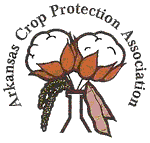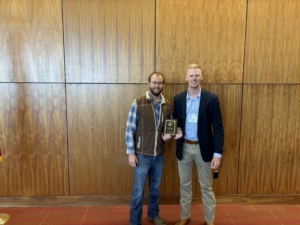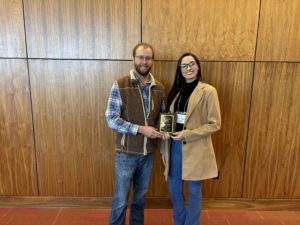Dodde won a first place award with a presentation titled Atrazine Mitigation Efforts with See & SprayTM Technology. Atrazine is one of the most used herbicides in corn production for control of many problematic weeds. In response to environmental concerns, the Environmental Protection Agency has proposed label changes to restrict the amount of atrazine runoff from treated fields. Therefore, research was conducted in 2024 at the Northeast Research and Extension Center near Keiser, AR, the West Tennessee Research and Education Center in Jackson, TN, and the Agronomy Center for Research and Education in West Lafayette, IN to determine if the use of John Deere’s See and SprayTM technology could reduce atrazine use in corn while maintaining effective weed control. A randomized complete block design experiment was established with four replications. All treatments, except for the nontreated check contained a preemergence application of amicarbazone, metribuzin, S-metolachlor, and paraquat. Postemergence (POST) treatments included combinations of glyphosate, atrazine, and mesotrione applied with See and Spray technology or broadcast. Weed control data for multiple species were collected for four weeks after POST treatment as well as the amount of herbicide sprayed at the time of POST treatments. On average, the See and Spray treatments sprayed 23% less area than the broadcast treatments, ranging from 15% to 32% savings. The only difference in weed control occurred with Palmer amaranth (Amaranthus palmeri) 4 weeks after the POST application. Plots receiving a broadcast glyphosate with a targeted atrazine application had the least Palmer amaranth control at this timing (94% control). No differences were seen at any other evaluation timings or with the other weeds evaluated. Based on these results, See and Spray technology could be an effective means of mitigating atrazine use in corn.
Souza won a first place award with a presentation titled Exploring the Effect of Fluridone Application Timing on Rice Tolerance. Crop tolerance to herbicides can be highly affected by growth stage at the time of application. In 2023, fluridone received a label for use in rice, providing a new site of action for use in the crop. To evaluate the effect of application timing on rice tolerance to fluridone, a field experiment was conducted in 2022 and 2023 at the Rice Research and Extension Center near Stuttgart, AR. The experiment was arranged as a randomized complete block design with four replications. Treatments included a weed-free control for comparison and fluridone applied at 0.15 lb ai/acre at ten different timings: 20 and 10 days preplant, preemergence (PRE), delayed-preemergence (DPRE), 1-leaf, 2-leaf, 3-leaf, 4-leaf, tillering (preflood), and immediately after flooding (postflood). Visible injury was assessed weekly, and rice canopy coverage was estimated 10 weeks after emergence (WAE). Rough rice grain yield was determined at harvest. In 2022, the highest injury observed at 3 WAE was 5%. However, in 2023, injury reached 24% by 3 WAE, caused by the PRE treatment. Following flood establishment, injury tended to increase in 2022, with the PRE and DPRE treatments causing 36% and 32% injury, respectively. In 2023, injury decreased at 10 WAE compared to the initial evaluation at 3 WAE across all treatments except for the PRE treatment, which resulted in 39% injury. In both years, the PRE treatment caused the greatest reduction in canopy coverage at 10 WAE, with a decrease of 4% and 21% in 2022 and 2023, respectively. The PRE and DPRE treatments led to yield reductions in 2022, whereas, in 2023, only the PRE application caused yield loss compared to the weed-free control. Based on these findings, application timing influences rice tolerance to fluridone, and early applications, especially PRE and DPRE should be avoided as indicated on the current label.




